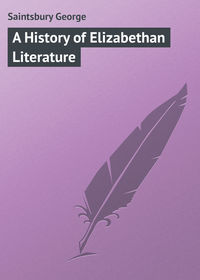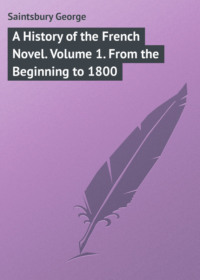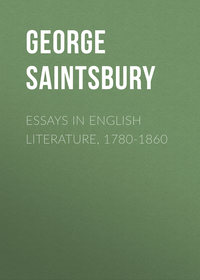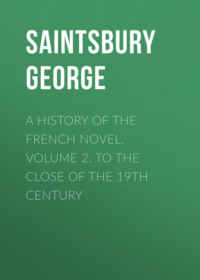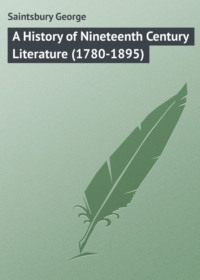 полная версия
полная версияПолная версия
A Short History of French Literature
Comédie Larmoyante. La Chaussée. Diderot.
In contrast to these three writers, who all followed the traditions of the comedy of Molière and Regnard, Nivelle de la Chaussée invented, or at least brought into fashion, what was called comédie larmoyante, or drame. La Chaussée was a good deal ridiculed by his contemporaries, notably by Piron, who devoted to him some of his most admirable epigrams. But he was popular, and not altogether undeservedly popular, though his drama occupied in French literary history something of the same place as that of Lillo and Moore in English. La Chaussée was followed by a greater writer, but a worse dramatist, than himself. While La Chaussée was a clever versifier and an adroit playwright, Diderot understood the theory both of poetry and of the theatre much better than he understood the practice. Thus L'École des Mères, La Gouvernante, Le Préjugé à la Mode are better plays than Le Père de Famille or Le Fils Naturel. It ought to be said that Diderot succeeded better in two small pieces, La Pièce et le Prologue and Est-il Bon? Est-il Méchant? which were never acted. It should perhaps also be explained that the peculiarity of what was almost indifferently called tragédie bourgeoise and comédie larmoyante is the choice of possible situations in real life, which neither of the two conventional treatments of heroic tragedy and comedy purely comic can afford. Many writers followed La Chaussée and Diderot. Of these the most important perhaps was Saurin, who, not content with regular tragedy and comedy, obtained much success with Beverley, an adaptation of Moore's Gamester, of which Diderot wrote an unacted version.
L'École des Bourgeois and L'Embarras des Richesses, by D'Allainval, one of the few French writers who experienced the privations of their English contemporaries in Grub Street, are good pieces, and so are the short La Pupille and the Originaux of Fagan, a clerk in the public service, who, like Lesage and Piron (Collé and Panard may be added), wrote vaudevilles, parades, etc. for the Théâtre de la Foire. In the titles of most of these pieces the close following of Molière, which was usual, and wisely usual, during the first half of the century, may be noticed.
Marivaux.
The same tradition is observed in one of the best comedies of the century, the Méchant of Gresset, which, like his poem of Ver-Vert, had a great success, and deserved it, being equally good as literature and as drama. Marivaux, without, perhaps, attaining as positive an excellence, was more original, and very much more productive. The fullest edition of his dramatic works contains thirty-two pieces, and even this is not complete. Several of them, Le Jeu de l'Amour et du Hasard, 1730, Le Legs, 1736, Les Fausses Confidences, 1737, have continued to be popular. All the work of Marivaux, dramatic and non-dramatic, is pervaded more or less by a peculiarity which at the time received the name of Marivaudage. This peculiarity consists partly in the sentiment, and partly in the phraseology. The former is characteristic of the eighteenth century, disguising a considerable affectation under a mask of simplicity, and the latter (sparkling with abundant, if somewhat precious wit) is ingeniously constructed to suit it and carry it off.
Of the three greatest literary names of the time, Diderot, it has been seen, tried the theatre not too happily. Voltaire, as successful in tragedy as his models permitted him to be, was not successful at all in comedy, and, indeed, rarely tried it. His best piece, Nanine, a dramatisation of Pamela, or at least suggested by it, is chiefly remarkable for being written in decasyllabic verse. The third, Rousseau, who lived to denounce the theatre, wrote a short operetta, Le Devin du Village, which is not without merit. Desmahis, a protégé of Voltaire, produced, in 1750, a good comedy, L'Impertinent, on a small scale; and La Noue, another of his favourites (for he was as indulgent to his juniors as he was jealous of men of his own standing), the Coquette Corrigée. A third member of the same class, Saurin, already twice mentioned, must be mentioned again, and still more deservedly, for Les Mœurs du Temps. The best dramatists, however, among the immediate followers of the Philosophes were Sedaine and Marmontel. Sedaine is, indeed, with the possible exception of Beaumarchais, the best dramatist of the last half of the century. Le Philosophe sans le Savoir, 1765, and La Gageure Imprévue, 1768, are both admirable pieces. The author, like many of his predecessors, was a constant worker for the Opéra Comique, and one of the best of the class. Marmontel also adopted this line of composition, to which the musical talent of Grétry gave, at the time, great advantages. His best light dramatic work is a kind of comedy vaudeville, the Ami de la Maison.
Beaumarchais.
Beyond all doubt, however, the most remarkable, if not the best, dramatist of the late eighteenth century is Beaumarchais. Some critics have seen in the enormous success of the Barbier de Séville, 1775, and the Mariage de Figaro, 1784, nothing but a succès de circonstance connected with the political ideas which were then fermenting in men's minds. This seems to be unjust, or rather it is unjust not to recognise something very like genius in the manner in which the author has succeeded in shaping his subject, without choosing a specially political one, so as to produce the effect acknowledged. The wit of these two plays, moreover, is indisputable. But it may be allowed that Beaumarchais' other productions are inferior, and that his Mémoires, which are not dramatic at all, contain as much wit as the Figaro plays. As a satirist of society and a contributor of illustrations to history, Beaumarchais must always hold a very high place, higher perhaps than as an artist in literature. Of his life, it is enough to say that he was born in 1731; became music master to the daughters of Louis XV.; engaged in a law-suit, the subject of the Mémoires, with some high legal functionaries; made a fortune by speculating and by contracts in the American war, and lost it by further speculations, one of which was the preparation of a sumptuous edition of Voltaire. Besides the Figaro plays, his chief dramatic works are Eugénie, Les Deux Amis, and lastly, La Mère Coupable, in which the characters of his two famous works reappear.
After Beaumarchais, but few comic authors demand mention. Collin d'Harleville, one of the pleasantest writers of light comedies in verse, produced Les Châteaux en Espagne, L'Inconstant, L'Optimiste, and Le Vieux Célibataire, 1792, all sparkling pieces, which only need freeing from the restraints of rhyme. Andrieux, the author of Les Étourdis, 1787, Le Trésor, Le Vieux Fat, and others, has something of the same character. Nepomucène Lemercier distinguished himself in comedy, chiefly by Plaute, in irregular verse, and by a comedy-drama, Pinto, in prose. These have his usual characteristics of somewhat spasmodic genius. Fabre d'Eglantine, the companion of Danton and Camille Desmoulins on the scaffold, is better remembered for his death than for his life. But his Intrigue Epistolaire and Philinte de Molière shew talent. Le Sourd, by Desforges, is an amusing play.
Characteristics of Eighteenth-century Drama.
It will be seen that the positive achievements of drama during this period were considerably superior to those of poetry. The tragedies of Voltaire are prodigies of literary cleverness. In comedy proper Lesage produced work of enduring value; Destouches, Marivaux, Piron, Gresset, and some others, work which does not require any very great indulgence to entitle it to the name, in the right sense, of classical; Beaumarchais, work which is indissolubly connected with great historical events, and which is not unworthy the connection. Moreover, as a matter of general literary history, the drama during this time displays numerous evidences of life and promise, as well as of decadence. The gradual recognition of the vaudeville as a separate literary kind gave occasion to much work, the ephemeral character of which should not be allowed to obscure its real literary excellence, and founded a school which is still living and flourishing with by no means simulated life. The attempt of La Chaussée and Diderot to widen the range and break down the barriers of legitimate drama was premature, and not altogether well directed; but it was the forerunner of the great and durable reaction of nearly a century later. Still the actual dramatic accomplishment of this period, though in many ways interesting, and to a certain extent positively valuable, is not of the first class. It is made up either of clever imitations and variations of modes which had already been expressed with greater perfection, and with far greater genius, by the preceding century, or of what may be fairly called dramatic pamphleteering, or else of tentative and immature experiments in reform, which came to nothing, or to very little, for the time being. Even its most gifted practitioners regarded it as a kind of journey-work, which was understood to lead to honour and profit, rather than as an art, in which honour and profit, if not entirely to be ignored, are altogether secondary considerations. Hence, in a lesser degree, the drama of the eighteenth century shares the same disadvantage which has been noted as characterising its poetry. Its value is a value of curiosity chiefly, a relative value. Indeed, as a mere mechanical art, drama sank even lower than poetry proper ever sank; and for fifty years at least before the romantic revival it may be doubted whether a single play was written, the destruction of which need greatly grieve even the most sensitive and appreciative student of French literary history.
CHAPTER III
NOVELISTS
The peculiarity of the eighteenth century in France as regards literature – that is to say, the application of great talents to almost every branch of literary production without the result of a distinct original growth in any one department – is nowhere more noticeable than in the department of prose fiction288. The names of Lesage, Prévost, Marivaux, Voltaire, Rousseau, are deservedly recorded among the list of the best novel writers. Yet, with the exception of Manon Lescaut, which for the time had no imitators, of the great works of Lesage which, admirable in execution, were by no means original in conception, and of the exquisite but comparatively insignificant variety of the prose Conte, of which Voltaire was the chief practitioner, nothing in the nature of a masterpiece, still less anything in the nature of an epoch-making work, was composed. The example of Manon was left for the nineteenth century to develop, the others either died out (the adventure romance, after Lesage's model, flourishing brilliantly in England, but hardly at all in France), or else were subordinated to a purpose, the purpose of advocating philosophe views, or of pandering to the not very healthy cravings of an altogether artificial society. Yet, so far as merely literary merits are concerned, few branches of literature were more fertile than this during the period.
Lesage.
The first, and on the whole, the most considerable name of the century in fiction is that of the author of Gil Blas. Alain René Lesage was born at Sarzeau, near Vannes, on the 8th of May, 1668, and died at Boulogne on the 17th of November, 1747. He was bred a lawyer, and should have had a fair competence, but, being early left an orphan, was deprived of most of his property by the dishonesty of his guardian. He married young, moreover, and, unlike most of the prominent men of letters of his day, never seems to have enjoyed any solid patronage or protection from any powerful man or woman. This is indeed sufficiently accounted for by anecdotes which exist showing his extreme independence of character. Like most men of talent in such circumstances, he turned, though not very early, to literature, and began by a translation of the 'Letters' of Aristaenetus. No great success could have awaited him in this line, and perhaps the greatest stroke of good-fortune in his life was the suggestion of the Abbé de Lyonne that he should turn his attention to Spanish literature, a suggestion which was not made more unpalatable by the present of a small annuity. He translated the 'New Don Quixote' of Avellaneda (than which he might have found a better subject), and he adapted freely plays from Rojas, Lope de Vega, and Calderon. It was not, however, till he was nearly forty that he produced anything of real merit. The Diable Boiteux appeared in 1707, and was at once popular. Still Lesage did not desert the stage, and the production of his admirable comedy Turcaret ought to have secured him success there. But the Comédie Française was at that time more under the influence of clique than at any other time of its history; and Lesage, disgusted with the treatment he received from it, gave himself up entirely to writing farces and operettas for the minor theatres, and to prose fiction. Gil Blas, his greatest work, originally appeared in 1715, but was not completed till twenty years later. He also wrote – besides one or two bright but trifling minor works of a fictitious character, La Valise Trouvée (a letter-bag supposed to be picked up), Une Journée des Parques, a keen piece of Lucianic satire, etc. – many other romances in the same general style as his great works, and more or less borrowed from Spanish originals. The chief of these are Guzman d'Alfarache, Estévanille Gonzalez, Le Bachelier de Salamanque, and a curious Defoe-like book entitled Vie et Aventures de M. de Beauchéne. In his old age he retired to the house of his second son, who held a canonry at Boulogne, and resided there for some years, until, in 1747, he died in his eightieth year. His works have hitherto been very insufficiently collected and edited.
Le Diable Boiteux and Gil Blas are far the greatest of Lesage's romances, and, as it happens, they are the most original, little except the starting-point being borrowed in the one case, and nothing but a few detached details in the other. Lesage was, however, true to the general spirit of his model, the picaroon romance of Spain, a kind of Roman d'Aventures transported from the days and conventional conditions of chivalry to those of ordinary but still adventurous life in the Peninsula. The directly satirical intention predominates in the Diable Boiteux, the more purely narrative faculty in Gil Blas. In both the piercing observation of human character, which Lesage possessed in a greater degree perhaps than any other French writer, appears, and so does his remarkable power of making the results of this observation live and move. No French writer is so little of a mere Frenchman as Lesage, and in this point of cosmopolitan humanity he may be compared, without extravagance, in kind if not in degree, to Shakespeare. Besides his skill in character-drawing, and his faculty of spicing his narrative with epigram, Lesage also possessed extraordinary narrative ability. His books are not remarkable for what is called plot, that is to say, the action rather continues indefinitely in a straight line than converges on a given and definite point. But this continuance is so adroitly managed that no break is felt, and the succession very seldom becomes tedious. The novel of Lesage is the immediate parent and pattern of that of Fielding and Smollett in England. It is somewhat remarkable that it had no successors of importance or merit in France. This is probably to be accounted for by the cosmopolitan tone which has been already remarked upon. Indeed Lesage, as a rule, has had less justice done to him by his countrymen than any other of their great writers. Yet his style, looked at merely from the point of view of art, is excellent, and perhaps superior to that of any of his contemporaries properly so called.
Close in the track of Madame de la Fayette followed Madame de Fontaines (Marie Louise Charlotte de Givri), the date of whose birth is unknown, but who died in 1730. She was a friend of Voltaire's youth, and her best work is named La Comtesse de Savoie, the date of the story being the eleventh century. She also wrote a short story of less merit called Aménophis. Madame de Tencin (Claudine Alexandrine Guérin), the mother of D'Alembert, the friend of Fontenelle, and one of the most famous salon-holders of the early eighteenth century, was a more fertile and a cleverer writer. She was born in 1681, and died in 1749. She had a bad heart, but an excellent head, and she showed her powers in the Mémoires du Comte de Comminges and the Siége de Calais, besides some minor works. The fault of almost all romances of the La Fayette school, the habit of throwing the scene into periods about which the writers knew nothing, appears in these works.
Marivaux.
But the first writer of fiction after Lesage who is worthy of separate mention at any length (for in these later centuries of our history there are, as any reader of books will understand, vast numbers of practitioners in every branch of literary art who are entirely unworthy of notice in a compendious history of literature) is Marivaux, an original and remarkable novelist, who, though by no possibility to be ranked among the great names of French literature, occupies a not inconsiderable place among those who are remarkable without being great. Pierre Carlet de Marivaux, whose strict paternal appellation was simply Pierre Carlet, was born at Paris on the 8th of February, 1688. His father was of Norman origin, and held employments in the financial branch of the public service. Very little is known of the son's youth, and indeed not much of his life. He is said to have produced his first play, Le Père Prudent et Equitable, at the age of eighteen, and his dramatic industry was thenceforward considerable. As a romancer he worked more by fits and starts. His first attempt at prose fiction is said to have been – for the authenticity of the attribution is not certain – a romance in a kind of pseudo-Spanish style, called Les Effets surprenants de la Sympathie, published six years later. Then he took to the sterile and ignoble literature of travesty, attacking Homer and Fénelon in the style of Scarron and Cotton. This brought him, through La Motte, under the influence of Fontenelle, to whom he owed not a little. He made a fortune and lost it in Law's bubble. Then he turned journalist, and after writing social articles in the Mercure, started a periodical himself, the nature of which is sufficiently shown by its borrowed title, Le Spectateur Français, 1722. At a later period he began another paper of the same kind, Le Cabinet du Philosophe, 1734. His plays, which have been already noticed, were written partly for the Comédie Française, and partly for a very popular Italian company which appeared in France during the second quarter of the century. But for the present purpose his works which concern us are the famous romance of Marianne, 1731-1742, and the less-known one of the Paysan Parvenu, 1735. His dramas, rather than his fictions, procured him a place in the Academy in 1742, and he died in 1763.
Marianne has been said to be the origin of Pamela, which may not be exactly the fact, though it is difficult not to believe that it gave Richardson his idea. But it is certain that it is a remarkable novel, and that it, rather than the plays, gave rise to the singular phrase Marivaudage, with which the author, not at all voluntarily, has enriched literature. The plot is simple enough. A poor but virtuous girl has adventures and recounts them, and the manner of recounting is extremely original. A morally faulty but intellectually admirable contemporary, Crébillon the younger, described this manner excellently by saying that the characters not only say everything that they have done and everything that they have thought, but everything that they would have liked to think but did not. This curious kind of mental analysis is expressed in a style which cannot be defended from the charge of affectation notwithstanding its extreme ingenuity and occasional wit. The real importance of Marianne in the history of fiction is that it is the first example of the novel of analysis rather than of incident (though incident is still prominent), and the first in which an elaborate style, strongly imbued with mannerism, is applied to this purpose. The Paysan Parvenu, the title of which suggested Restif's novel Le Paysan Perverti, and which was probably not without influence on Joseph Andrews, is not very different in manner from Marianne, and, like it, was left unfinished after publication in parts at long intervals.
Prévost
A third eminent writer of novels was, in point of production, a contemporary of Lesage and Marivaux, though he was nearly thirty years younger than the first, and fully ten years younger than the second, and he more than either of them set the example of the modern novel. The Abbé Prévost, sometimes called Prévost d'Exilles, was born at Hesdin, in Picardy, in April, 1697. He was brought up by the Jesuits, and after a curious hesitation between entering the order and becoming a soldier (he actually served for some time) he joined the famous community of the Benedictines of Saint Maur, the most learned monastic body in the Roman church. When he did this he was four-and-twenty, and he continued for some six years to give himself up to study, not without interludes of professorial work and of preaching. He became, however, disgusted with his order, and unfortunately left his convent before technical permission had been given; a proceeding which kept him an exile from France for several years. It was at this time (1728) that he threw himself into novel-writing, taking his models, and in some cases, his scenes and characters, from England, which he visited, and of which he was a fervent admirer. He obtained permission to return in 1735, and then started a paper called Le Pour et le Contre, something like those of Marivaux, but more like a modern critical review. He received the protection of several persons of position and influence, notably the Prince de Conti and the Chancellor D'Aguesseau, and for nearly thirty years led a laborious literary life, in the course of which he is said to have written nearly a hundred volumes, mostly compilations. His death, which occurred in November, 1763, was perhaps the most horrible in literary history. He was on his way from Paris to his cottage near Chantilly, when he was struck by apoplexy. A stupid village doctor took him for dead, and began a post-mortem examination to discover the cause. Prévost revived at the stroke of the knife, but was so injured by it that he expired shortly afterwards.
His chief works of fiction are the Mémoires d'un Homme de Qualité, 1729, Clèveland, and the Doyen de Killérine, 1735, romances of adventure occupying a middle place between those of Lesage and Marivaux. But he would have been long forgotten had it not been for an episode or rather postscript of the Mémoires entitled Manon Lescaut, in which all competent criticism recognises the first masterpiece of French literature which can properly be called a novel. Manon is a young girl with whom the Chevalier des Grieux, almost as young as herself, falls frantically in love. The pair fly to Paris, and the novel is occupied with the description of Manon's faithlessness – a faithlessness based not on want of love for Des Grieux, but on an overmastering desire for luxury and comfort with which he cannot always supply her. The story, which is narrated by Des Grieux, and which has a most pathetic ending, is chiefly remarkable for the perfect simplicity and absolute life-likeness of the character-drawing. The despairing constancy of Des Grieux, conscious of the vileness of his idol, yet unable to help loving her, the sober goodness of his friend Tiberge, the roystering villany of Manon's brother Lescaut, and, above all, the surprising and novel, but strictly practical and reasonable, figure of Manon, who, in her way, loves Des Grieux, who has no objection to deceive her richer lovers for him, but whose first craving is for material well-being and prosperity – make up a gallery which has rarely been exceeded in power and interest.




